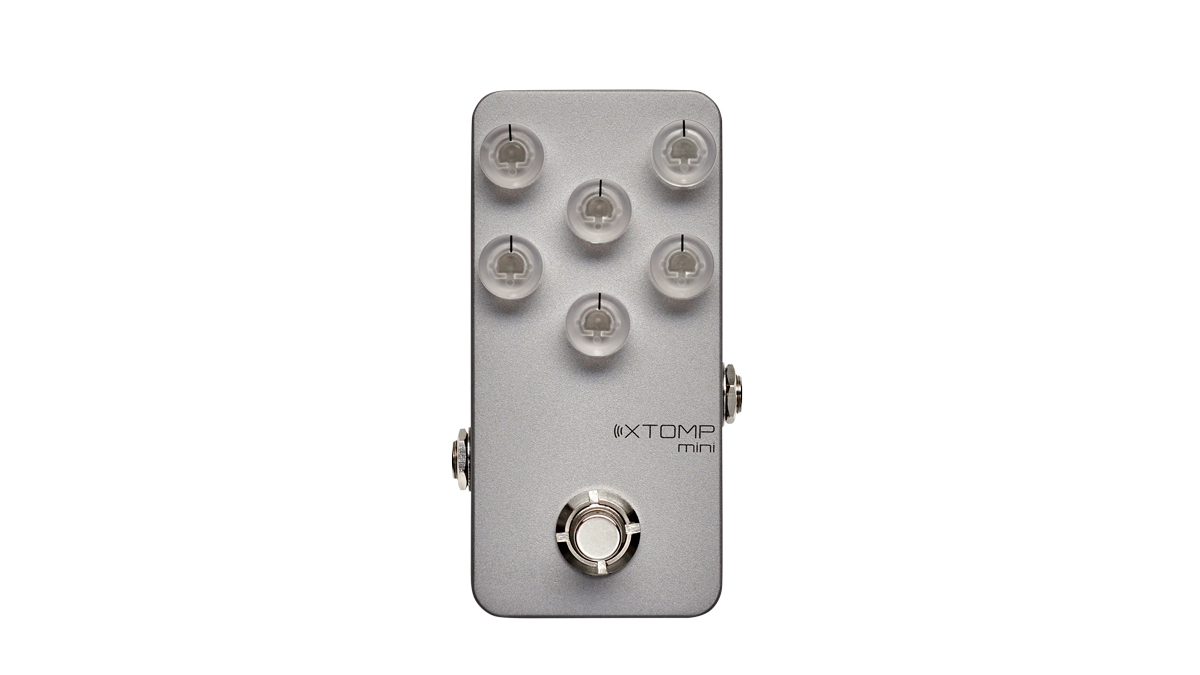MusicRadar Verdict
This Xtomp Mini, quite possibly, represents the most practical addition for your ’board out there.
Pros
- +
Compact.
- +
Numerous effects.
- +
Practical bypass options.
Cons
- -
Doesn’t load Hotone’s Combo effects.
- -
Pointing a phone at the pedal isn’t for everyone.
MusicRadar's got your back
Hotone’s original Xtomp, which made its debut last year, might have seemed an enigma to anyone looking at it and wondering what on earth its knobs did as none of them were labelled.
But perhaps that was the clue, because those knobs could be whatever you wanted them to be: the Xtomp presented a smart pedal that could be configured to be any effect you wanted, chameleon-style.
Now its creator has brought out a new version, the Xtomp Mini, which has lost the original’s stereo inputs and outputs, in turn making it slightly smaller with a more compact and pedalboard-friendly footprint.
The key to using the pedal is an app that provides 140 digitally modelled effects, amp sims and speaker sims (with new models being added twice a month), any of which can be loaded singly into the pedal.
The app itself takes several forms: it can run on a computer (Mac or Windows), making a USB connection to the pedal, or it can be a mobile app for iOS or Android, utilising a wireless Bluetooth connection to load the pedal with whatever effect you want. You just zap a new effect into the pedal at any time from your phone…
Sounds
As supplied, our pedal comes with a very nice three-knob delay loaded, but with the free app downloaded to our iPhone, we’re able to scroll through the available models, choose one and load it into the pedal. Initially, some of the more complex models can take up to two minutes to load, but once a particular model has been loaded, it will only take a few seconds the next time you want to select it.
When you load an effect into the Xtomp, the knobs that tweak the parameters for that effect light up - some in different colours relating to their function - although you’ll have to remember what parameter each controls from looking at the representation in the app.
Want all the hottest music and gear news, reviews, deals, features and more, direct to your inbox? Sign up here.
The app’s Library page has all the models neatly laid out and categorised, mainly single amplifiers, cabinets or effects, but also with some models working as a pair (Combo).

However, those Combo effects (plus those in the Special and Signature categories) are the preserve of the original Xtomp and won’t load into the Mini. The variety of single effects, however, is outstanding, with models of many well-known types available, some with thinly disguised names: if you want a Tube Screamer, Big Muff, RAT, Phase 90, CE-1, Uni-Vibe and many others, you’ll find pretty accurate emulations here courtesy of Hotone’s Comprehensive Dynamic Circuit Modeling (CDCM) technology. In A/B tests with some original dirt pedals, we find the Xtomp versions to be pretty close and note that the amp sims capture the flavour of the real thing.
But as an add-on to an existing setup, it’s likely that the main appeal here lies in the Frequency, Modulation and Ambient effects where you’ll find a vast array of EQ tools, delays, reverbs, flangers, phasers, choruses, tremolos… and some more unusual effects such as an Electro-Harmonix Q-Tron emulation.
While it may lack the stereo operation and dual effects of its older sibling, the Mini has two advantages that, in our view, make it a more enticing proposition.
Firstly, it’s cheaper (the original retails for £199) and, secondly, it’s easier to integrate into a pedalboard. With the advantage over conventional pedals in that it can be any effect you want it to be, a single Xtomp Mini would greatly expand your sonic possibilities - but imagine the potential with several Minis, offering a complete revamp of your rig at any time.
While the loading of the pedal from a mobile phone is well implemented, it’s not something you’d want to be messing with during a set: getting your phone out, selecting the app, scrolling to the effect you want, loading it and then resetting the knobs for the new effect may be a little too much to ask.
But it’s really no hassle if you need to configure it to a particular effect to see you through a gig, and could be a lifesaver for those who play with several different bands and need a different set of pedals for each.
Trevor Curwen has played guitar for several decades – he's also mimed it on the UK's Top of the Pops. Much of his working life, though, has been spent behind the mixing desk, during which time he has built up a solid collection of the guitars, amps and pedals needed to cover just about any studio session. He writes pedal reviews for Guitarist and has contributed to Total Guitar, MusicRadar and Future Music among others.

